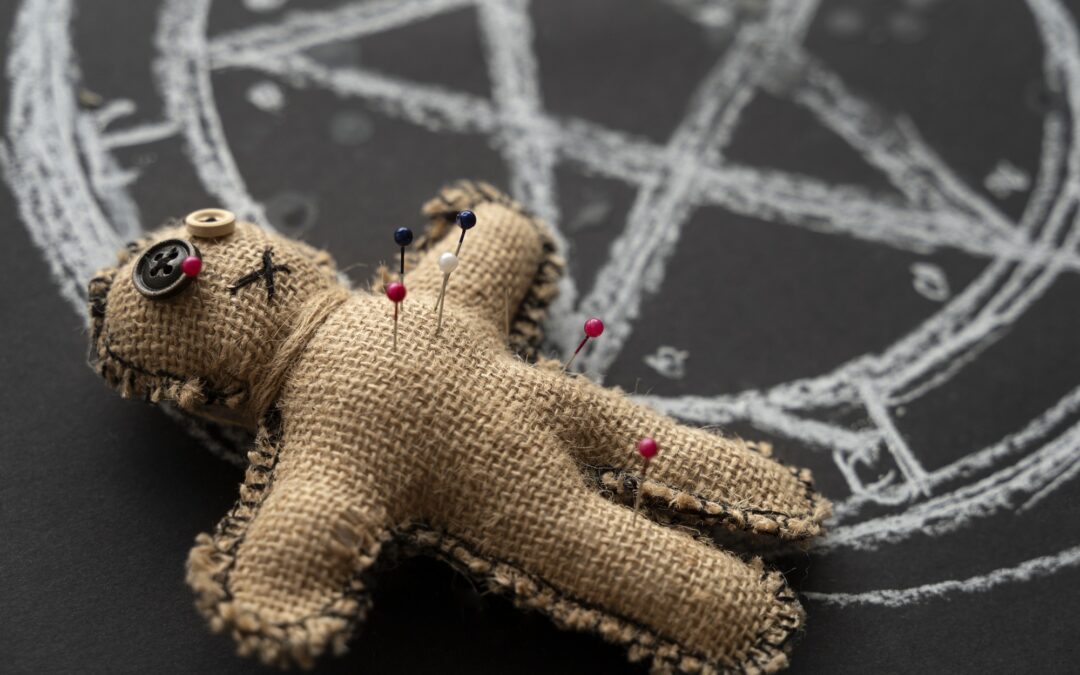In North American popular culture, including cinema, literature, and oral history, the mere mention of voodoo dolls is enough to strike horror and inspire visions of murderous vengeance. Stories like this suggest that Voodoo dolls are created by members of Caribbean cults who harbor resentment against an outsider. The doll is pricked by its creator, who wishes ill upon the recipient (who may suffer physical harm or perhaps die). Is there any truth to such claims? Do Voodoo dolls really exist?
Voodoo, or more accurately written Vodou, is a religion prevalent in Haiti and other parts of the Caribbean. Although Vodou artists create dolls, these toys aren’t used for vengeance at all. Vodou dolls are utilized in the healing process and as a conduit to the spirits of the departed. This story about effigy dolls being used as a conduit for evil powers released in a rite is not indigenous to the Caribbean; rather, it originates in the ancient Middle East, the cradle of western civilization.
Voodoo Dolls: What Are They?
Small human effigies, called voodoo dolls, may be purchased at stores all across New Orleans and abroad. They are created by tying together two sticks to form a body, with the ends jutting out to represent arms. The shape is often draped in a triangular piece of brightly colored fabric, and Spanish moss is utilized to bolster the form. Black fabric or wood is used for the head, and basic characteristics like eyes, a nose, and a mouth are painted on it. They often have ostentatious embellishments like feathers and sequins and come along with a pin or dagger and detailed use instructions.
Read Also: How To Make Lovers Attract Spells, Mind-blowing Love Curses & Spell Of Separation
These Voodoo dolls are only produced for the tourist trade in New Orleans and the Caribbean, where they are sold as cheap trinkets in tourist stores, open-air markets, and tossed in parades. Practitioners of Vodou do not utilize them.
Sculptures from Around the Globe
Figurines, depictions of people that are common across many civilizations, date back to the Upper Paleolithic so-called “Venus figurines” and include human effigies like the Voodoo dolls, both the actual ones and the ones sold in stores are examples. These depictions are often of fictitious deities or heroes or of real people who have been molded after an ideal. Among the various proposed motivations, vengeance is never mentioned.
Figure of Venus from Willendorf.
Assyrian rites from the first millennium BCE, as shown by Bronze Age Akkadian literature (c. 8th–6th century BCE), used figures created with the express intent of causing damage to another person; this practice was later adopted by Greco–Roman Egypt (c. 1st–2nd century CE). Pricking dolls with pins was a common method of enforcing a binding curse in ancient Egyptian culture. In one inscription from the 7th century BCE, a king of Mesopotamia curses his rival:
May your likeness be melted away in flames or dissolved in water, just as wax statues and clay figurines are.
It’s possible that the notion of wicked Voodoo dolls as shown in Hollywood horror films is considerably newer, dating back to the 1950s when thousands of “cashew dolls” were brought to the United States from Haiti. These were crafted out of real cashew shells and decorated with the eyeballs of the jequirity bean, a poisonous kind of castor bean that is especially dangerous for small children. In 1958, the United States government issued a Public Health Warning stating that the dolls posed a “significant risk of death.”
Why Do People Use Voodoo Dolls?
Haitian Vodou followers use miniature effigies known as a fetish or bocio into ceremonies, a practice that was transmitted to the country from West Africa. Slaves from these cultures transported their doll customs to the New World. The Vodou religion was created when certain Africans combined their indigenous faith with Catholicism.
Dolls are used in ceremonies in West Africa, Haiti, and New Orleans, but these rites have nothing to do with harming anybody. On the contrary, their purpose is to aid with recovery. They serve to keep lines of communication open between the living and the dead when strung from trees at cemeteries. Tacking them upside down to trees sends the message that their maker should cease worrying about a detrimental influence.
Vodouisants
Pwen refers to the objects used by Vodouisants in their ceremonies to contact and summon the lwa and loa. A pwen is an item in the Vodou religion that is dedicated to a certain lwa by using its favorite ingredients. They are designed to entice a lwa and secure the power of its influence for the user. Dolls are only one of the many doll-like manifestations of pwen. According to Vodouisants, a pwen need not even be a tangible item.
Pwen dolls may range from simple poppets to highly detailed works of art. At first glance, these dolls can be mistaken for Voodoo dolls. But like with any pwen, their intent is to call upon lwa in order to address the Vodouisant’s needs, whether they are physical, spiritual, or otherwise.


